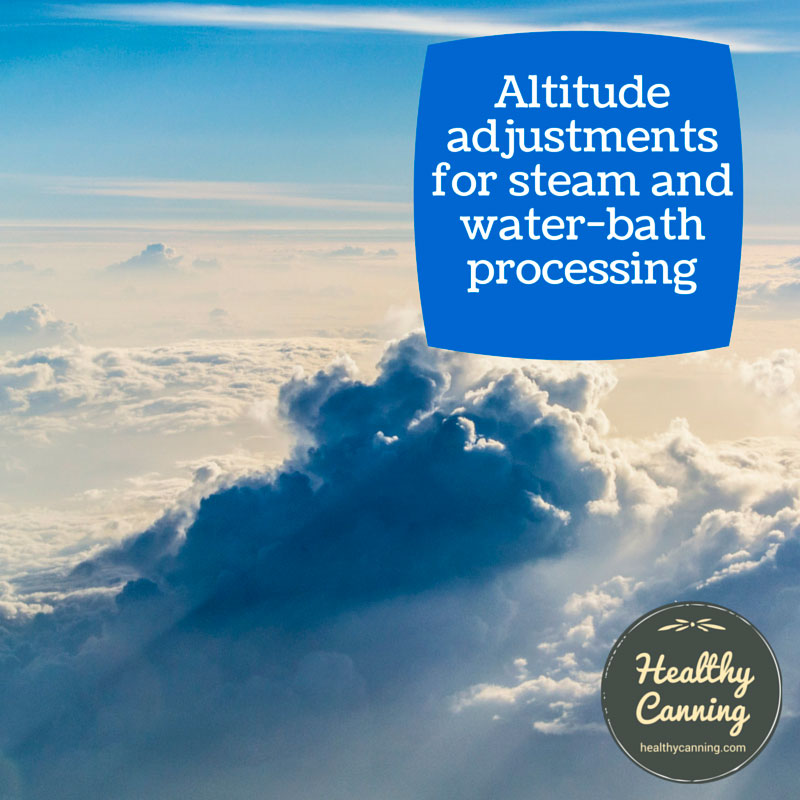
Unsplash / Pixabay.com / 2015 / CC0 1.0
In home canning, you must account for altitude affecting your processing when you are higher than 300 metres (1000 feet).
Pro tip! You can use Google maps to find your altitude. You can enter your entire address in: e.g 123 Queen Street, Upper Lower Bottom, Wisconsin, USA.
Water-bath processing elevation adjustments
| Altitude (feet) | Altitude (metres) | Add to processing time... |
|---|---|---|
| 0 -1000 | 0 - 305 | 0 |
| 1,001 - 3,000 | 306 - 915 | 5 |
| 3,001 - 6,000 | 916 - 1,830 | 10 |
| 6,001 - 8,000 | 1,831 - 2,440 | 15 |
| 8,000 - 10,000 | 2,441 - 3,050 | 20 |
Default sea level for canning purposes is deemed to be 0 to 1000 feet (0 to 300 metres).
Giving processing times for sea level processing is therefore the default in canning recipes.
All water bath / steam canner processing times for high-acid foods on this web site are based on that default: canning at or below 305 metres (1000 feet).
When you are processing at altitudes higher than this, you must extend the times based on the chart above.
Some government-issued recipes may give processing times already adjusted for the elevation of their region. For instance, Utah State Extension Service issues many recipes already adjusted for 1200 metres (4,000+ feet).
The Ball Blue Book says,
Just as it does when you bake, altitude affects canning recipes. In most home canning recipes, recommended processing times are stated for use at elevations of sea level 0 to 1000 feet (0 to 305 metres.) At higher elevations, water boils at temperatures lower than 100 C (212 F). Lower temperatures are less effective in destroying microorganisms, therefore adjustments must be made to heat processing instructions to extend exposure to adequate heat to destroy microorganisms.” [1] Bernardin Guide to Home Preserving. Toronto, Canada: Bernardin Ltd. 2013, page 12.
Barometric pressure is reduced at high altitudes, affecting the temperature at which water boils…. When using the boiling water method, additional processing time must be allowed.” [2] Ibid., Page 5.
See also: Altitude Adjustments for Pressure Canning
No steam canning for longer than 45 minutes
If altitude adjustments would require a particular food product / jar size to be processed for longer than 45 minutes, then you cannot do it in a steam canner, simply because of technical limitations: the basic steam canners that many people buy don’t hold enough water to generate steam for longer than that (though the multi-canner steam canners do hold more water.) You’ll need to water bath instead. (For something like plain tomato products or plain fruit products, you could also consider pressure canning, with pressure adjusted for altitude.)
See more background information here.
Sources
Bernardin. Canning at high altitudes. (Metric conversions. Accessed February 2015.)
Bernardin Guide to Home Preserving. Toronto, Canada: Bernardin Ltd. 2013, page 12
United States Department of Agriculture (USDA). Selecting the Correct Processing Time. In: Complete guide to home canning. Agriculture information bulletin No. 539. 2015. Pages 1-22 – 23. (accessed February 2016.)
References

Vivian phinizy
Hello
I have a glass top stove and a outdoor gas grill. Which do you you recommend for high acid foods? And which method do you suggest and the canner I should use? Thank you in advance.